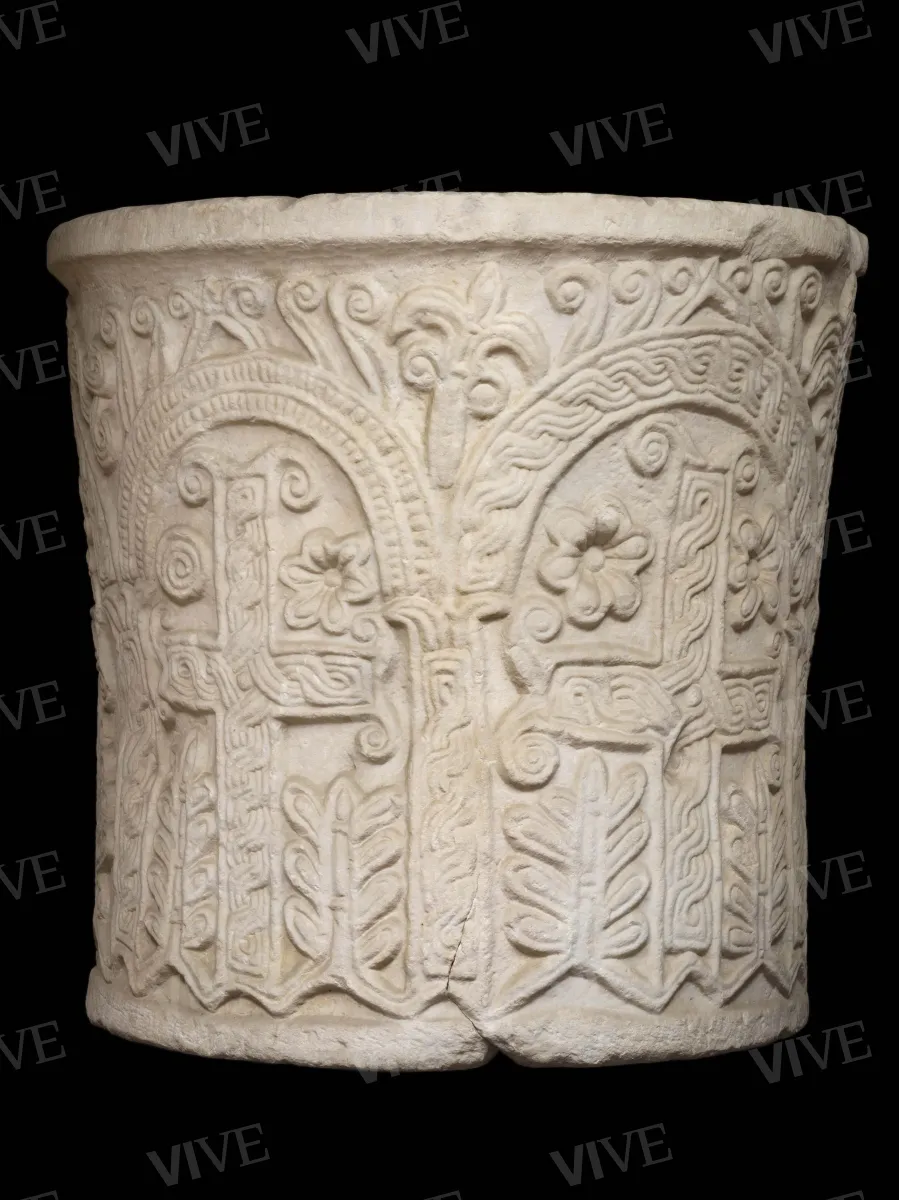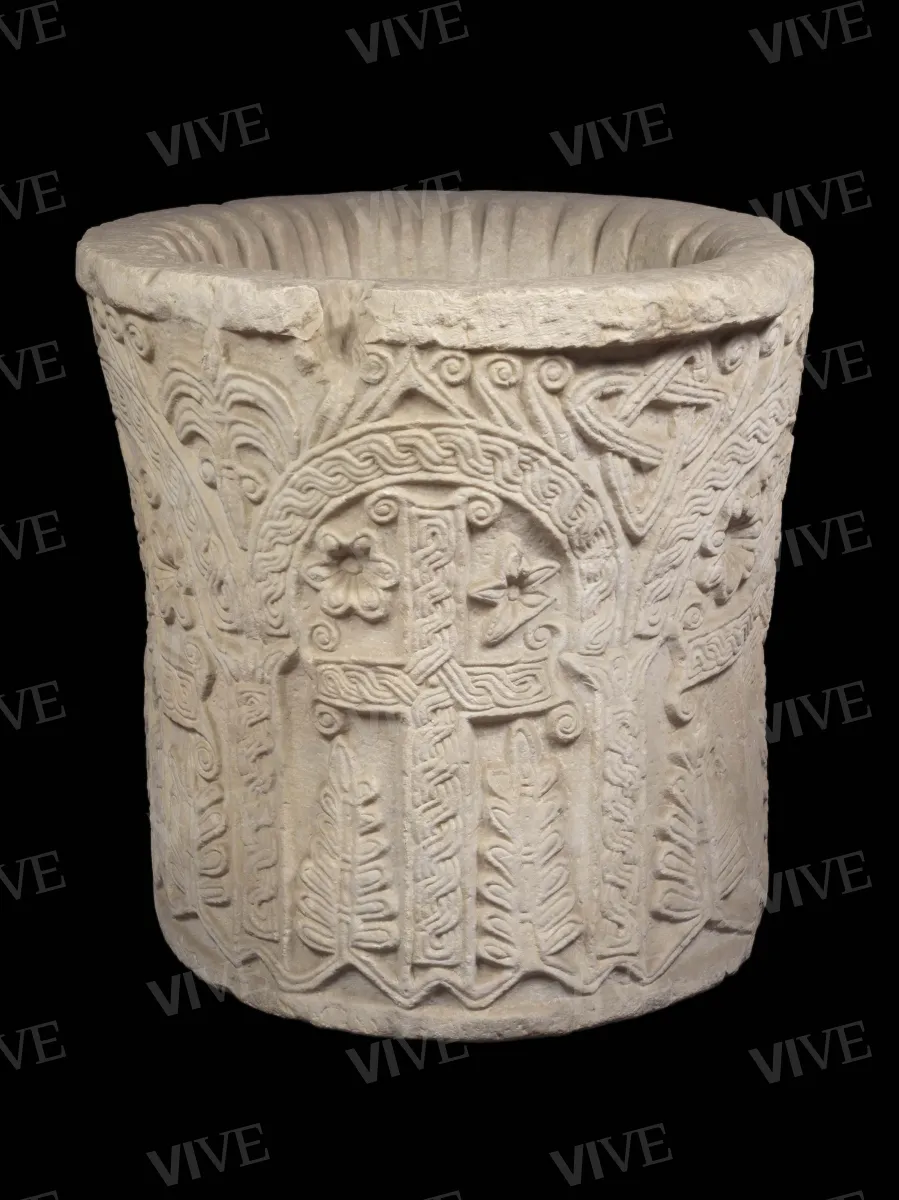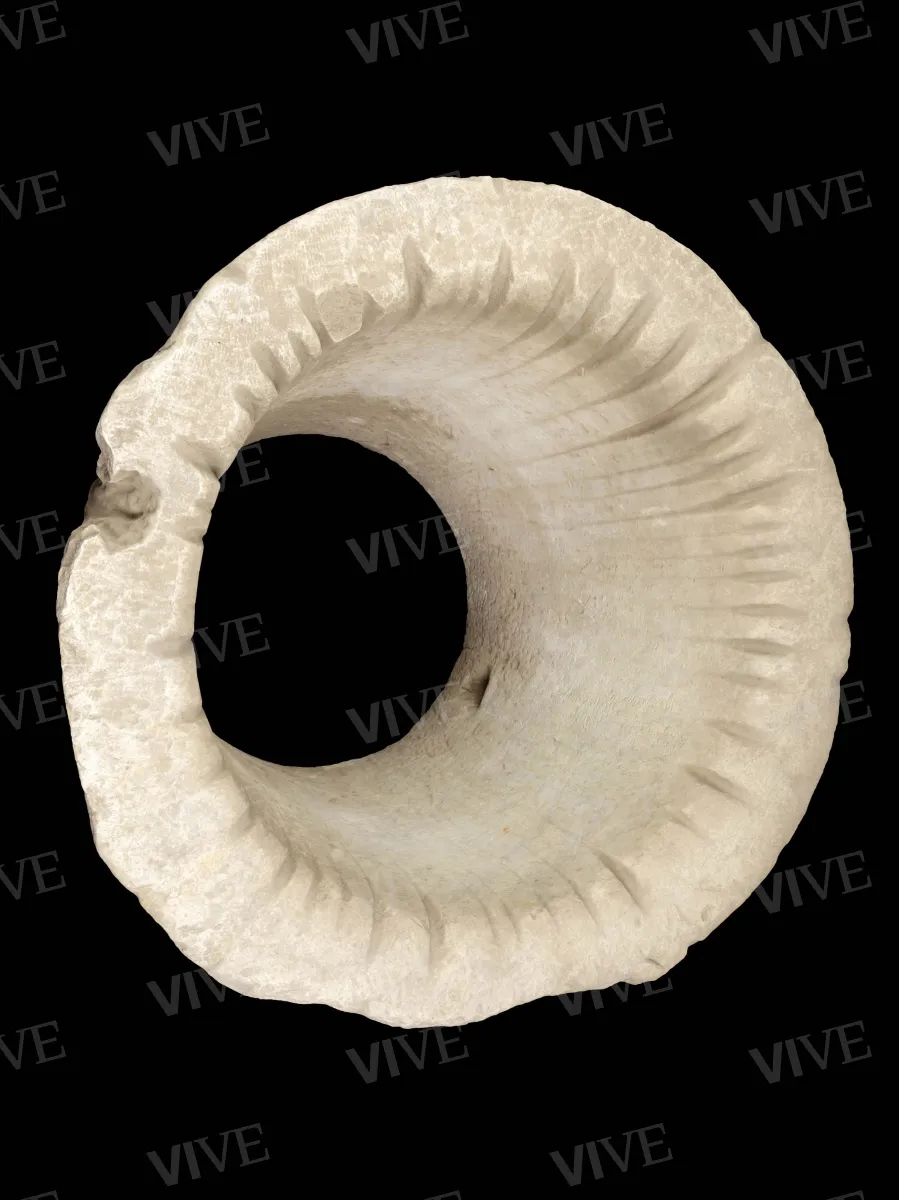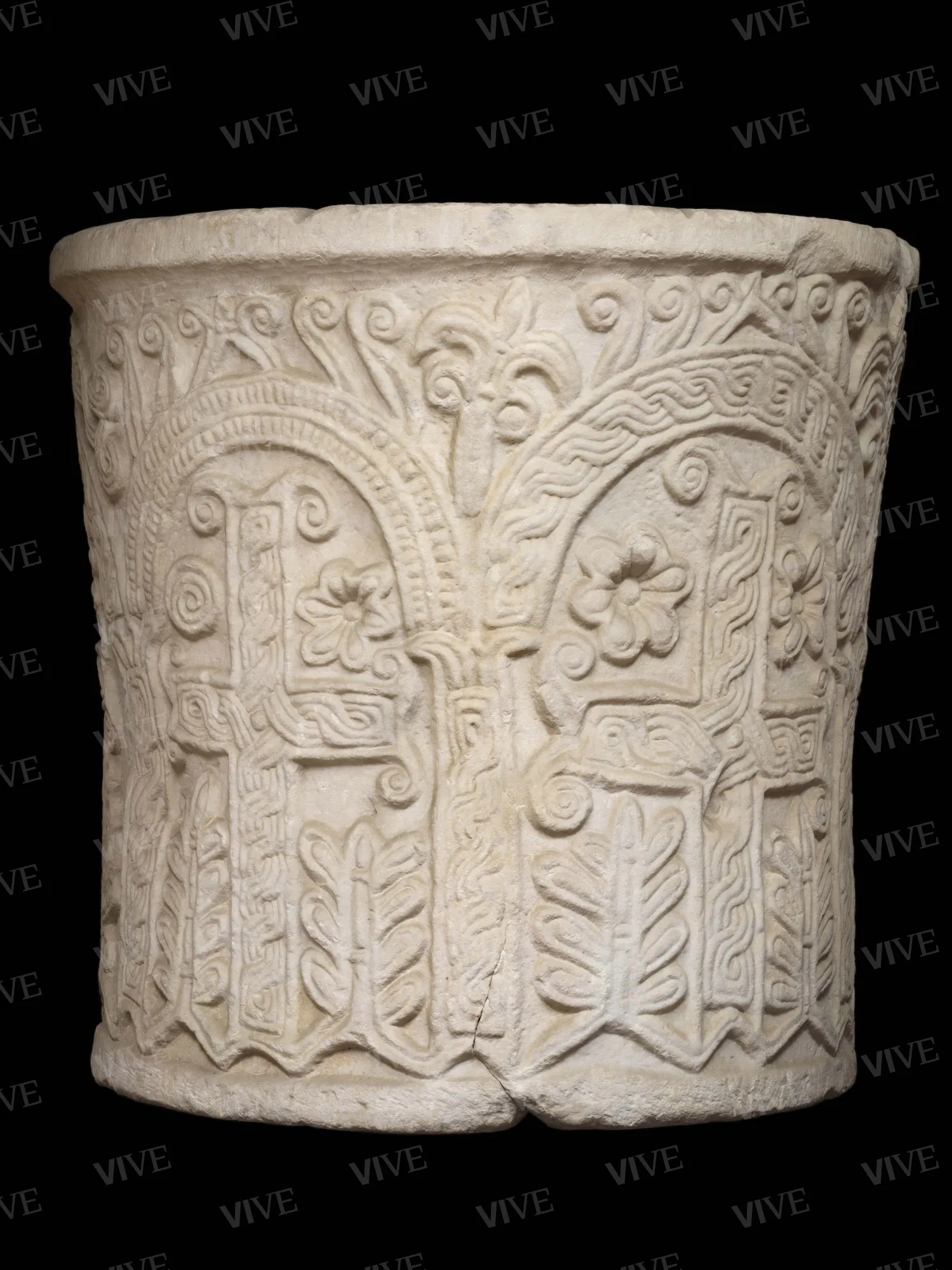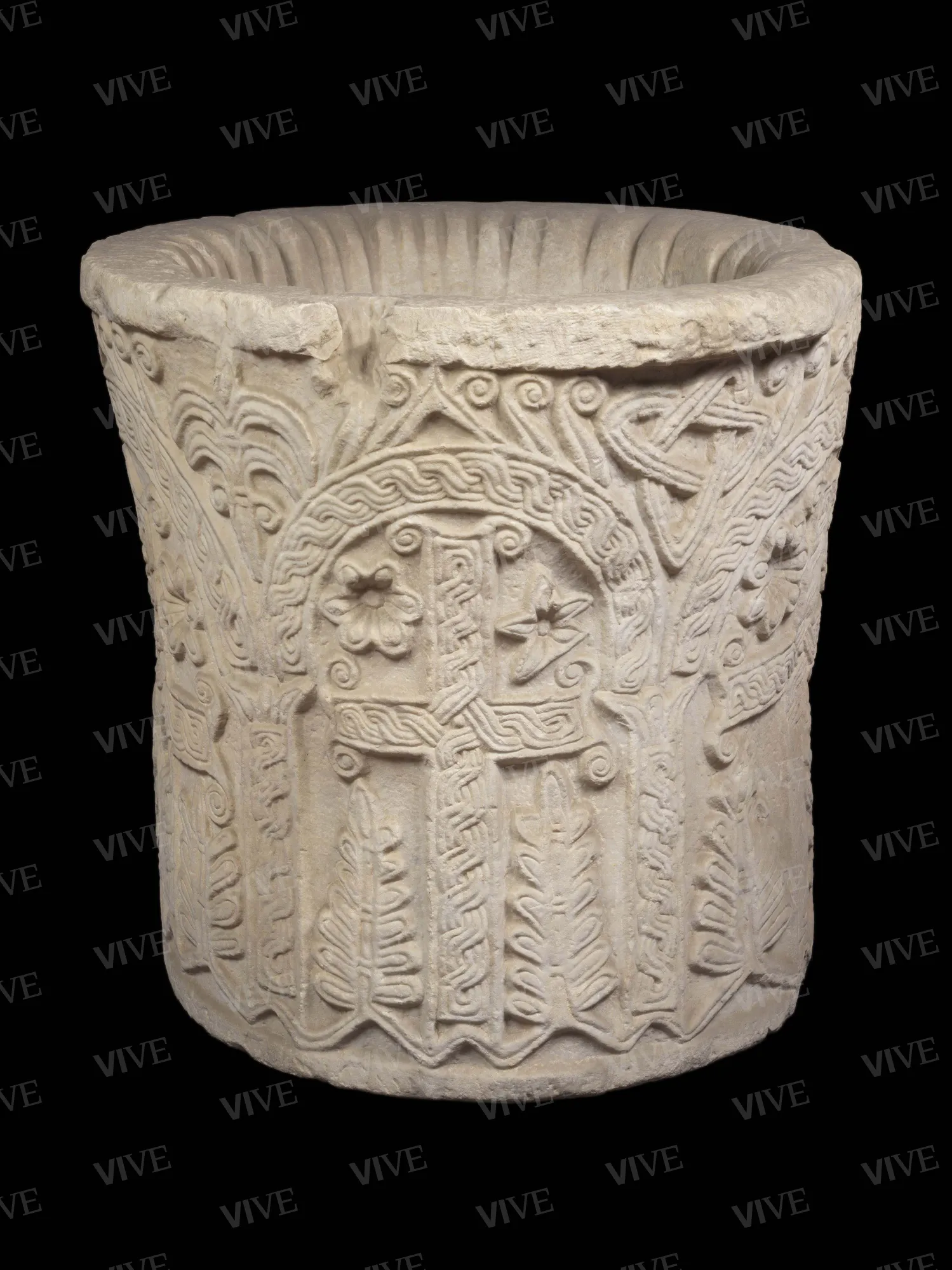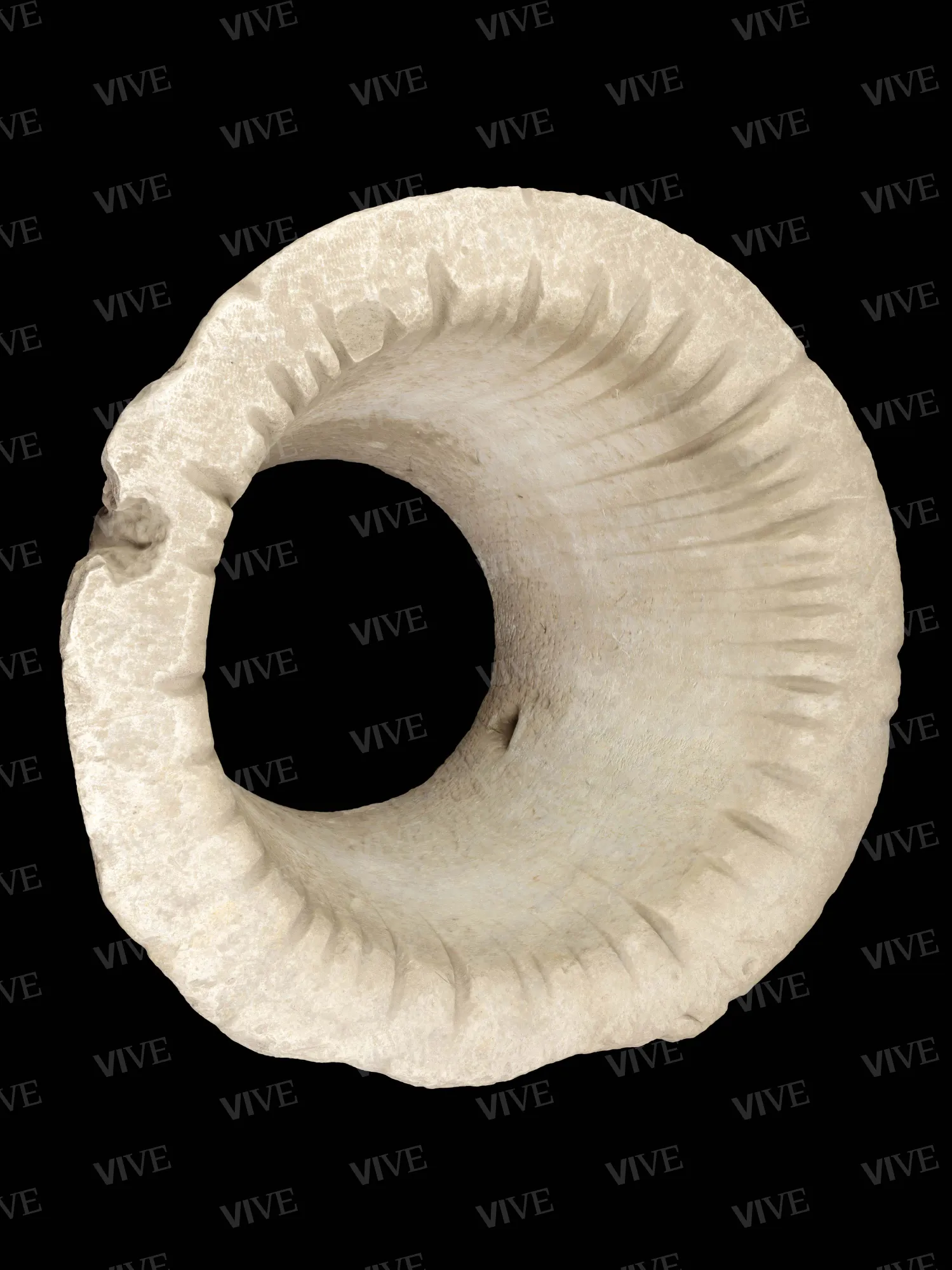Puteal with crosses in aediculae
Roman milieu First half of 9th century
White Carrara marble puteal, or well curb, ornamented with five aediculae framing crosses filled in with braids of two-lined wickerwork motif ribbon with scrolled extremities, flanked by polylobate-leafed saplings and trunk with spindle whorl motif springing from a zigzag base, and two recessed rosettes. The guilloche arches, like the foliate capital columns, are surmounted by a divergent double order of recurring waves, with lilies, palmettes, Solomon’s knots, and a knotted skein ending in eyelets set in the spandrels.
White Carrara marble puteal, or well curb, ornamented with five aediculae framing crosses filled in with braids of two-lined wickerwork motif ribbon with scrolled extremities, flanked by polylobate-leafed saplings and trunk with spindle whorl motif springing from a zigzag base, and two recessed rosettes. The guilloche arches, like the foliate capital columns, are surmounted by a divergent double order of recurring waves, with lilies, palmettes, Solomon’s knots, and a knotted skein ending in eyelets set in the spandrels.
Details of work
Catalog entry
The puteal features dense ornamentation that almost completely covers its outer surface. The primary ornamental theme—a cross framed by aedicula—which in the form of the palmette under arches is attested as early as the second quarter of the eighth century (Kautzsch 1939; Russo 1985), is modernized by the widespread use of interlacing two-lined wickerwork motif ribbons and recurring waves.
The motif dates from the early Christian period and relates to the iconography of the Anastasis (Pani Ermini 1974b), taking upon itself a complex set of symbolic values (Roth-Rubi 2015), which refer to the Tree of Life or arbor vitae (the palms flanking the cross), Paradise (the aedicula as the gateway to Paradise), the cosmological order (the rosettes representing the sun and moon), and salvation through Christ (the sacrifice of the cross). Already present in high medieval Roman sculptural works in the presbyterial enclosure of St. Peter’s in the Vatican at the time of Gregory III (731–741) (Guiglia Guidobaldi 2002; Ballardini 2008), it made extensive inroads into Rome and central and northern Italy in the first half of the ninth century.
The five puteal aediculae show disparities in their technical–formal treatment, a sign of the presence in the same workshop of inconsistently skilled and trained stone masons, an attested fact of the period (Ballardini 2010).
In its iconographic layout, the aedicula, consisting of two small columns with foliate capitals on which the round arch is set, is filled by a large Latin cross with scrolled extremities, all ornamented in guilloche. The base of the cross is connected to the small columns by virtue of a zigzagging wave motif, from which extend two pyramid shaped saplings with spindle whorl motif trunks and podded leaves, most likely cypresses (Frugoni 1990) or palms (De Santis 2000), which flank the longitudinal arm of the cross. In the upper half are two rosettes with rounded, lance-shaped petals and a central bud with a hollowed core. Above the arch, divergent rows of recurring waves in the form of caulicles branch out from a central lily form resembling an aeolian capital. In the spandrels of the arches, lilies and palmettes alternate with caulicles, Solomon’s knots in a two-lined wickerwork motif ribbon, and, in that (less visible?) section characterized by a decidedly more modest quality compared to the rest of the decoration, a tangled two-lined wickerwork motif ribbon ending in eyelets. To the right, the arch replaces the guilloche with a double row, separated by a semicircular section strip, of ovolos arranged in a radial pattern. Below the arch there are two rosettes, the one on the left leading to a circle spiral.
The puteal, also known as a wellhead or well curb, formed the parapet protecting the well's mouth. Four early medieval puteals have survived in Rome, and were originally created when the ancient aqueducts were abandoned (Betti 1998). They are all cylindrical in shape—although polygonal ones have been uncovered elsewhere—adorned with the same iconographic range characterizing Roman liturgical fixtures of the time (Paroli 2001). Two of them, from the atrium of San Giovanni a Porta Latina and from the Lateran cloister (Melucco Vaccaro 1974, figs. 36 and 78), do not allow for a formal and stylistic comparison, except for the latter, which presents a set of common themes such as recurring wave arches, crosses, and palmettes, which, however, are distributed according to a different and entirely original layout. Of the other two, held in the Museo Nazionale dell’Alto Medioevo (Melucco Vaccaro, Paroli 1995, figs. 120-121), now part of the Museo delle Civiltà in Rome, only one, dated to the mid-ninth century, presents ornamental elements similar to those of our puteal, with five aediculae, recurring waves, lilies, and palmettes instead of crosses. Thus far, no other examples have been found of the particular flared-mouth form of the puteal from Palazzo Venezia and its exuberant decorative layout.
As has been speculated (Mazzanti 1896; Hermanin 1945, then Pani Ermini 1974), the puteal in all likelihood comes from the church of Sant’Agata in diaconia on the Quirinal, and must originally have had a lustral function linked to the purificatory rite of lousma that sources say was celebrated on Thursdays at the Roman diaconia (Marrou 1940) since the time of Hadrian I (772–795). The cross and symbolic motifs of the ornament emphasize and enhance the purifying and redemptive implication of the rite. Later, at an unspecified date, the puteal was probably repurposed (perhaps as a trough, Latini 2003), as the large hole made a third of the way from the base seems to suggest.
The iconographic theme adopted by the puteal is attested in Rome on tomb slabs, antependia, transennae, and puteals since the late eighth century and is so widespread that it constitutes the “basic vocabulary of early medieval sculptural language” (Roth-Rubi 2015). In fact, it is often found on reliefs that differ only in style and with no certain attestation for the eighth century in Rome (the fragment with sapling from Santa Maria in Cosmedin was already excluded by Melucco Vaccaro, 1974, fig. 108, from the other furnishings in the sacred building attributed to Hadrian I). Though this motif was already being used in sculpture of the second half of the eighth century in the Lombardy area, as for example on the pluteus of the patriarch Siguald in Cividale (Lusuardi Siena, Piva 2001), it goes back much further to early Christian and Ravenna origins, as in the sarcophagus of Honorius in the Mausoleum of Galla Placidia, and recurs in sarcophagi with the Anastasis (Pani Ermini 1974b notes that, from the second half of the eight century, worshippers were reduced to symbolic representation and replaced by rosettes and palms). In Rome a decoration very similar to the Eastern one was probably part of the presbytery enclosure commissioned by Gregory III (731–741) in Saint Peter’s in the Vatican—as hypothesized on the basis of the attribution to the presbytery complex of the pluteus fragments now held by the Vatican Grottoes and the Berlin Museums (Russo 1985; Ballardini 2008)—and set a standard for Carolingian production from the late eighth century (Paroli 2001).
Evidence of the individual motifs can be seen in the use of concave corolla flowers, carved with a slight curvature in the above-mentioned Siguald pluteus, which was already more pronounced in the frame fragments from Santa Maria in Cosmedin (Melucco Vaccaro 1974, fig. 106) determined to have been commissioned by Hadrian I (772–795); concave-hearted rosettes and saplings very similar to those on the puteal, however, decorate the ciborium arch or pergula from Saint John Lateran (Melucco Vaccaro 1974, fig. 61) from the second quarter of the ninth century. Saplings characterized by segmented trunks akin to classical fuserole and profiled leaves are found in the fragment from the demolitions of Sant’Andrea in Vincis held at the Palazzo Braschi Museo di Roma (inv. 41230, Betti 2003), in that of the ciborium arch or pergula from the church of Santi Bonifacio e Alessio (Trinci Cecchelli 1976, fig. 16), dated to the papacy of Leo III (795–816), even though greater stylistic adherence to our artifact can be found in the later fragments of a walled pluteus in the cloister of San Cosimato (Kautzsch 1939, fig. 58; Barclay Lloyd, Bull-Simonsen Einaudi 1998).
These stylistic elements could hardly be those referred to in the report on the restoration of the church of Sant’Agata in diaconia by Leo III (795-816) (Pani Ermini 1974, p. 54). It is true, however, that the Liber Pontificalis gives news of the gift of a robe by Gregory IV (827–844) to the monastery of Sant'Agata (LP II, 70), and, although there are no officially mentioned restoration or refurbishing works related to the monastery, we cannot rule out the possibility that the diaconia might have been provided with a new puteal perhaps precisely thanks to this donation.
Valentina Brancone
Entry published on 12 February 2025
State of conservation
Good. Chipped along top edge, with hole one-third of the way from base, showing signs of wear on inner edge due to rubbing from ropes used to lift water buckets.
Restorations and analyses
2002–2003 (restoration directed by Maria Giulia Barberini and Maria Selene Sconci, undertaken for the layout of the Museo di Palazzo Venezia Lapidarium).
Provenance
Rome, church of Sant’Agata in diaconia at the Quirinal (?);
Found during excavations in the Quirinal area (1870), formerly in the Cipolla collection and thence, from 1876, in the Museo Artistico Industriale;
Rome, Museo di Palazzo Venezia since 1957.
Exhibition history
Rome, Castel Sant’Angelo, Mostra retrospettiva in occasione dell’Esposizione Universale del 1911, 1911.
Sources and documents
Rome, Archivio Storico Capitolino, Elenco degli oggetti d’arte che si conservano presso il Museo Artistico Industriale, 1884. Delibera del Consiglio Comunale n. 13 del 27 ottobre 1884, n. 233;
Rome, Archivio della Galleria Nazionale d’Arte Antica di Palazzo Barberini, Libro 5° dell’inventario, Fondo M.A.I., manuscript edited by V. Rosati, A. Ferrari, G. Ferrari, n.d. (early twentieth century), no. 45;
Ferrari Giulio, Museo Artistico Industriale di Roma. Catalogo delle collezioni, Rome 1906, 15, no. 45;
Rome, Archivio del Museo del Palazzo di Venezia, Resoconto della riunione per la concessione degli oggetti del Museo Artistico Industriale in deposito al Museo di Palazzo Venezia (August 5, 1952, Prof. E. Lavagnino, Prof. A. M. Colini, Dr. C. Pietrangeli, Prof. A. Santangelo), with attached inventory, no. 373.
References
Kautzsch Rudolf, Die römische Schmuckkunst in Stein vom 6. bis zum 10 Jahrhundert, in «Römisches Jahrbuch für Kunstgeschichte», III, 1939, pp. 3-73;
Marrou Henri-Iréné, L’origine orientale des diaconies romaines, in «Mélanges de l’École française de Rome. Moyen-Age, Temps modernes», 57, 1940, pp. 95-142;
Hermanin Federico, L'Arte in Roma dal secolo VIII al secolo XIV, Bologna 1945;
Melucco Vaccaro Alessandra, La Diocesi di Roma, t. III, La II regione ecclesiastica, Corpus della scultura altomedievale, VII, Spoleto 1974;
Pani Ermini Letizia, La Diocesi di Roma, t. I, La IV regione ecclesiastica, Corpus della scultura altomedievale, VII, Spoleto 1974;
Pani Ermini Letizia, La Diocesi di Roma, t. II, La raccolta dei Fori imperiali, Corpus della scultura altomedievale, VII, Spoleto 1974 (Pani Ermini 1974b);
Trinci Cecchelli Margherita, La Diocesi di Roma, t. IV, La I regione ecclesiastica, Corpus della scultura altomedievale, VII, Spoleto 1976;
Russo Eugenio, La recinzione del presbiterio di San Pietro in Vaticano dal VI all’VIII secolo, in «Atti della Pontificia Accademia Romana di Archeologia. Rendiconti», 55-56 (1982-1983/1983-1984), 1985, pp. 3-33;
Frugoni Chiara, Alberi (in Paradiso voluptatis), in L’ambiente vegetale nell’Alto Medioevo. Settimane di studio del Centro italiano di studi sull’Alto Medioevo (30 marzo-5 aprile 1989), XXXVII, vol. II, Spoleto 1990, pp. 724-762;
Melucco Vaccaro Alessandra, Paroli Lidia, La Diocesi di Roma, t. VI, Il Museo dell’alto Medioevo, Corpus della scultura altomedievale, VII, Spoleto 1995;
Barclay Lloyd Joan, Bull-Simonsen Karin, SS. Cosma e Damiano in Mica Aurea. Architettura, storia e storiografia di un monastero romano soppresso, Roma 1998;
Betti Fabio, Puteale ad vocem, in Enciclopedia dell’Arte Medievale Treccani, IX, Roma 1998, pp. 811-816;
De Santis Paola, ad vocem Palma, in Bisconti Fabrizio (a cura di), Temi di iconografia paleocristiana, Città del Vaticano 2000, pp. 238-240;
Paroli Lidia, La scultura a Roma tra il VI e il IX secolo, in Arena Maria Stella, Delogu Paolo, Paroli Linda et al. (a cura di), Roma dall’Antichità al Medioevo. Archeologia e storia nel Museo Romano Crypta Balbi, vol. I, Milano 2001, pp. 132-143, 487-493;
Lusuardi Siena Maria Silvia, Piva Paola, Scultura decorativa e arredo liturgico a Cividale e in Friuli tra VIII e IX secolo, in Paolo Diacono e il Friuli altomedievale (VI-IX secolo). XIV Congresso Internazionale del CISAM (Cividale del Friuli-Bottenicco di Moimacco, 24-29 settembre 1999), Spoleto 2001, pp. 493-594;
Guiglia Guidobaldi Alessandra, La scultura di arredo liturgico nelle chiese di Roma: il momento bizantino, in Guidobaldi Federico, Guiglia Guidobaldi Alessandra (a cura di), Ecclesiae urbis. Atti del Congresso internazionale di studi sulle chiese di Roma (IV-X secolo) (Roma, 4-10 settembre 2000), III, Città del Vaticano 2002, pp. 1479-1524;
Latini Massimo, Sculture altomedievali inedite del Museo Nazionale del Palazzo di Venezia in Roma, in «Rivista dell’Istituto Nazionale d’Archeologia e Storia dell’Arte», 57, 2003, pp. 113-152;
Betti Fabio, Sculture carolingie del Lapidario del Museo di Roma: materiale inedito e contesti di provenienza, in «Bollettino del Musei Comunali di Roma», XVII, n.s. 2003, pp. 142-161;
Barberini Maria Giulia, Quintiliani Giulia, Raimondo Filippo, Palazzo Venezia, il Palazzetto e il suo Lapidarium. Un viaggio tra i frammenti della Storia di Roma, Roma 2006;
Ballardini Antonella, Scultura per l’arredo liturgico nella Roma di Pasquale I: tra modelli paleocristiani e Flechtwerk, in Quintavalle Arturo Carlo (a cura di), Medioevo: arte e storia, X Convegno internazionale di studi (Pavia, 18-22 settembre 2007), Milano-Parma 2008, pp. 225-246;
Ballardini Antonella, Scultura a Roma: standards qualitativi e committenza (VIII secolo), in Pace Valentino, L’VIII secolo: un secolo inquieto. Atti del Convegno internazionale di studi (Cividale del Friuli, 4-7 dicembre 2008), Udine 2010, pp. 141-148;
Roth-Rubi Katrin (in collaborazione con Sennhauser Rudolph), Die frühe Marmorskulptur aus dem Kloster St. Johann in Müstair, Ostfildern 2015.

